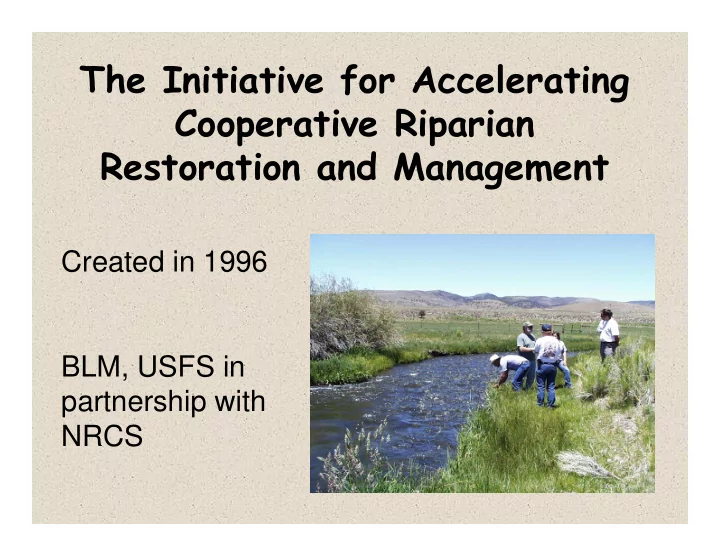

The Initiative for Accelerating Cooperative Riparian Restoration and Management Created in 1996 BLM, USFS in partnership with NRCS
‘Healthy Streams Through Bringing People Together’
“Restoration will not happen by regulation, changes in the law, more money or any of the normal bureaucratic approaches. It will only occur through the integration of ecological, economic and social factors, and participation of affected interests.”
Increase awareness and shared understanding of riparian function and sustainability across a large number of diverse people.
Program Implementation • Riparian Coordination Network • Community-Based Training • Service Trips
Proper Functioning Condition = Assessment Method vegetation hydrology soil
How can What further management W h evaluations a t be improved? m a y b e l i m i are t i n g ? appropriate? What’s working well?
Proper Functioning Condition = Communication Tool Provides common terms, definitions and concepts important to building a shared understanding and vision among diverse stakeholders.
Help identify decision space... • Dissipate stream energy • Reduce erosion • Increased water quality and quantity • Filter sediment • Diverse ponding • Capture bedload and channel • Aid floodplain characteristics development • Habitat for fish and • Improve floodwater wildlife retention and • Greater biodiversity groundwater recharge • Forage for livestock • Develop root masses that stabilize stream banks
TRANSITION...
Evaluation Findings... Evaluation Findings... Strategy Revisions Strategy Revisions
Program Activities • 300 briefings and presentations – 10,000 people • 400 workshops – 12,000 people • 175 service trips – 3,000 people
‘Extremely Satisfied’ • Instructor attributes - knowledge - professionalism - responsiveness - willingness to engage in two way communication • Products and services delivered
Did Particpant Knowledge Increase? no 100% yes 80% 60% 40% 20% 0% relationship determining determine design importance of relationship between functionality minimum monitoring experienced between stream conditions strategies ID team function and attributes and relative to values processes stream potential and capability
PFC Training Sessions PFC Training Sessions • Lack of diverse Lack of diverse • participation participation • Limited long Limited long- -term term • improvement in improvement in cooperation cooperation
Training sessions are important to building awareness and a shared understanding... ...the initiative’s mission cannot be fulfilled through training sessions alone .
On-The-Ground Improvements Associated with Service Trips 100% yes 80% no 60% 40% 20% 0% working cooperative improved riparian cooperatively management plans condition
Lower Rates of Success � Lack of up-front participation by all stakeholders. � Insufficient opportunities for dialogue and mutual learning. � Limited follow-up.
Strategy Revisions Strategy Revisions PFC training sessions... • Engage in deliberate and personal outreach • Combine training and place-based problem solving Service trips... • Use pre-work to encourage up-front participation • Facilitate opportunities for dialogue and mutual learning • Engage in follow-up activities Network... • Increase network ability to respond to a range of community needs
Institutional Barriers
Institutional barriers Institutionalization Process Agency Organizational Support Hierarchy Workforce Constraints
Agency Support Agency Support • Differing levels of support from Differing levels of support from • partnering agencies and individuals partnering agencies and individuals • Current organizational cultures do not Current organizational cultures do not • create time and priority for the activities create time and priority for the activities associated with this type of work associated with this type of work • Bureaucracies are naturally resistant to Bureaucracies are naturally resistant to • risk taking, innovation and integration risk taking, innovation and integration
Institutionalization Process • Few incentives for acting outside of traditional problem solving approaches • Few mechanisms for reporting benefits gained by employee participation in this initiative
Organizational Hierarchy Lack of clear and consistent message across all ‘appropriate lines of authority’ supporting innovative approaches to problem solving has been a barrier to agency support for this initiative
Workforce Constraints Workforce Constraints Organizational downsizing + increasing responsibility = additional work !
Many agency employees trained in the bio- physical aspects of natural resource management... …some are disinterested or lack the skills to address the social dimensions of natural resource management.
There are not enough specialists available to participate in the type of interdisciplinary dialogue needed to properly assess specific riparian conditions... Vegetation Erosion - Hydrology Deposition
It is often difficult to share resources across disciplinary, programmatic and jurisdictional boundaries...
Thank you… Questions?
Recommend
More recommend